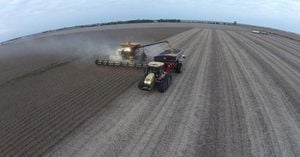A single case of atypical Bovine Spongiform Encephalopathy (BSE), commonly referred to as mad cow disease, has been confirmed on a farm located in Dumfries and Galloway, Scotland. The Scottish government announced this development recently, specifying precautionary movement restrictions imposed at the site to cover other animals potentially exposed to the affected cow. These measures are part of the government’s stringent efforts to monitor and control any risks associated with BSE.
Atypical BSE occurs spontaneously and is distinct from the classical strain of the disease, which can be transmitted to humans through the consumption of contaminated beef products. Officials have assured the public during their announcement, reinforcing the fact there is no known risk to human health and confirming the infected animal had not entered the food chain.
Food Standards Scotland emphasized this point, stating, "Food Standards Scotland confirms there is no risk to human health as a result of this isolated case." This diligent monitoring is part of Scotland’s established protocol, which has been under continuous scrutiny since the BSE crisis peaked during the 1990s.
The case was spotted thanks to routine surveillance efforts, demonstrating the effectiveness of the systems currently placed for tracking BSE-related incidents. Scottish agriculture minister Jim Fairlie noted, "Following confirmation of this case, the Scottish Government and other agencies took swift and rigorous actions to protect the agricultural sector." He credited the animal owner for their quick judgment, stating, "Their decisive action has allowed us to isolate the case at speed, minimizing its impact on the broader industry."
The Chief Veterinary Officer, Sheila Voas, supported Fairlie’s sentiments by highlighting the rapid detection of the case as evidence of the robustness of Scotland's surveillance system. Voas stated, "We are working closely with the Animal and Plant Health Agency, and other partners to identify where the disease originated from." This combined effort includes tracing the affected animal’s cohorts, including any offspring, which will be isolated as part of the control measures.
Apart from expressing gratitude to the owner for their vigilance, Fairlie also reminded farmers to remain vigilant and proactive, encouraging them to seek veterinary advice if any doubts lingered about their own herds. "If any farmers are concerned, I would urge them to seek veterinary advice," he said. This advice aims to not only alleviate concerns but also to bolster confidence among the farming community.
Officials at Food Standards Scotland have reiterated the importance of existing stringent regulations. Ian McWatt, deputy chief executive of the organization mentioned, "Strict controls are still enforced to safeguard consumers from the risk of BSE. Consumers can be assured these protective measures remain intact, with Food Standards Scotland’s veterinarians and meat hygiene inspectors working tirelessly to prioritize safety across all abattoirs in Scotland."
Over the years, public concern over BSE has been acute, particularly when it peaked back in the 1980s and 1990s, resulting in thousands of cattle being culled to prevent the spread of the disease. The industry's recovery since then has been closely monitored through prevention laws and industry reforms.
While there have been instances of BSE reported within the UK, including another case of classical BSE earlier this year in Ayrshire, the confirmation of this atypical case signifies the authorities’ preparedness and responsive nature. According to reports, the last recorded atypical BSE case occurred earlier this year. The ability to quickly identify and address these cases is integral to maintaining public health confidence.
Historic data showcases the nature of these outbreaks. The 1980s epidemic saw about 180,000 cattle affected and led to the slaughter of around 4.4 million cattle as the government battled to contain the crisis. Consequently, Scotland imposed notable changes to its farming and meat inspection systems to mitigate future risks.
This latest case reiterates the importance of rigorous monitoring practices and swift government action. The public response will undoubtedly hinge on how well officials continue to manage any outbreaks and communicate findings transparently. The surveillance systems currently employed not only serve as preventive measures but are also pivotal for preserving consumer trust within the agricultural community.
Today’s announcement carries considerable weight within the agricultural sector. The movement restrictions and heightened investigations are precautionary measures to encourage safe practices moving forward. Scotland's government reassures both farmers and consumers of their commitment to health security, fostering goodwill and confidence within the community.
With the specter of past crises looming, the actions taken around this isolated incident could lead to broader discussions around agricultural safety and the effectiveness of disease management protocols. Continuous scrutiny, improvements, and public education about BSE and similar diseases will be fundamental as the agricultural industry moves forward.
While the situation is being monitored closely, the clear communication from authorities and the implementation of thorough health safeguards is encouraging. It’s important for everyone involved—be it farmers, government bodies, or consumers—to work collaboratively to uphold the integrity and safety of the beef market. This approach could be the key to effectively managing current concerns and preventing future issues.



